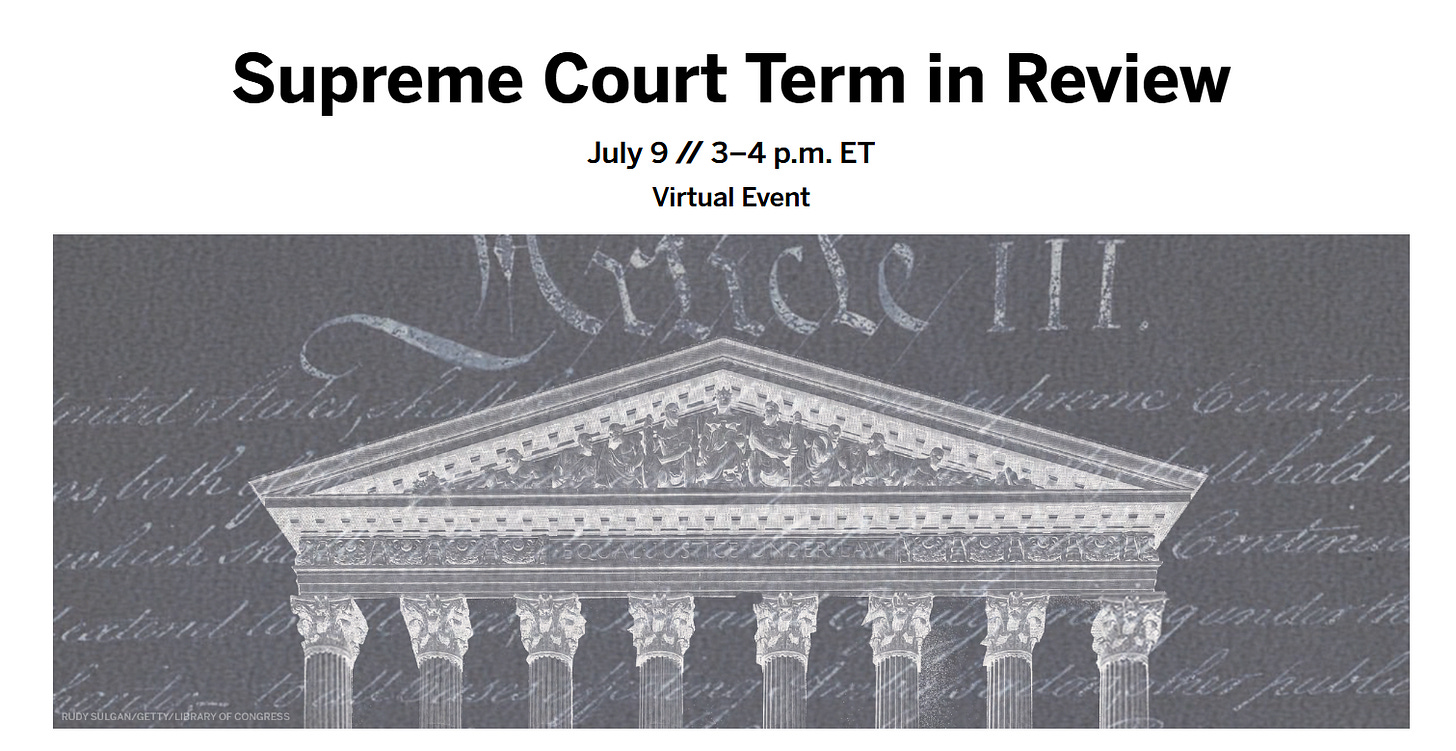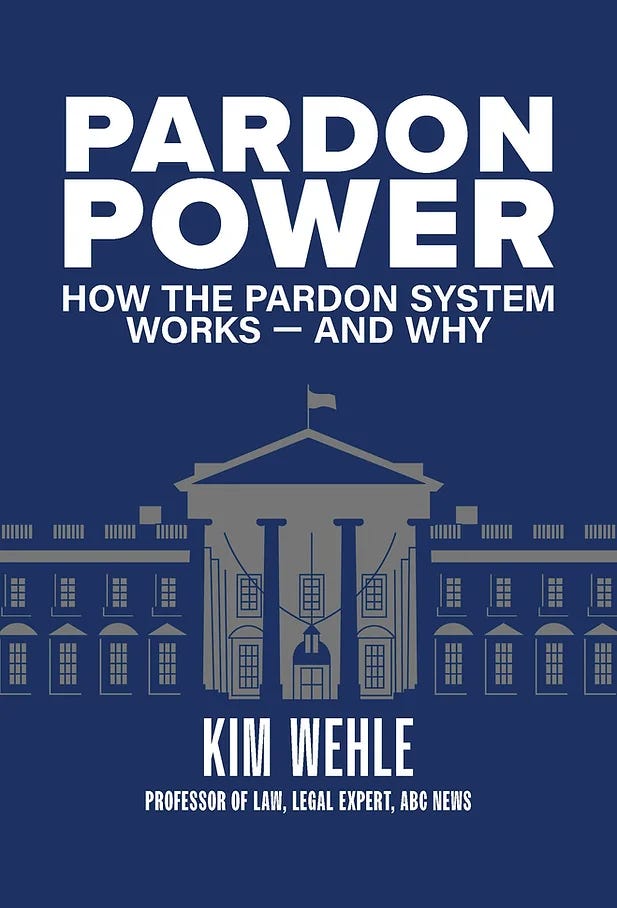What the Supreme Court majority means for the rule of law
Join me this Wednesday for a Brennan Center discussion of recent Supreme Court opinions and the future of the rule of law
This Wednesday at 3 P.M., I will be joining Joyce Vance and Cecillia Wang for a Brennan Center discussion of the recent Supreme Court decisions and what they mean for the future of the rule of law. Please join us!
The Supreme Court just ruled on a range of crucial issues, including access to healthcare, public education, political representation, and the ability of lower federal courts to keep the government in line with the rule of law in United States v. Skrmetti, Mahmoud v. Taylor, Trump v. Wilcox, Medina v. Planned Parenthood South Atlantic, Trump v. CASA, and Department of Homeland Security v. D.V.D.
Many of these decisions emerged from the emergency docket, or what some call the “shadow docket,” which we will be discussing on Wednesday. In her dissent in Wilcox, Justice Elena Kagan wrote that the “emergency docket, while fit for some things, should not be used to overrule or revise existing law.”
“We consider emergency applications ‘on a short fuse without benefit of full briefing and oral argument’; and we resolve them without fully (or at all) stating our reasons.”
The far-right majority on the Supreme Court has done some major things this squirrelly way. The result? The general public doesn’t know what is really going on. Yet it affects all of us.
Here’s a preview of a few of the major cases we will be discussing.
Seriously, this event is worth your time!
This newsletter unpacks the law in plain language. Please share it widely — and if you can, consider upgrading to paid.
I’m immensely grateful for your support!
Mahmoud v. Taylor
This case involved a challenge to the Maryland Montgomery County Public Schools’ decision to eliminate a policy that allowed parents to opt their children out of class when storybooks with LGBTQ+ characters and themes were being read.
The parents argued that the books went against their religious beliefs, and without the opt-out policy, the school was forcing the children to participate in classroom instruction that violated their faith.
The Supreme Court majority held for the parents, reasoning that children are unable to discern that just because something has widespread approval doesn’t mean everyone should accept it. The justices found that the storybooks posed a threat because of “the potentially coercive nature of classroom instruction of this kind.”
The ruling now sets the stage for all sorts of classroom material to be subject to opt-out policies so long as the parents can prove that their child is exposed to content or ideas that conflict with their religious beliefs.
Trump v. Wilcox
In this case, the Supreme Court majority allowed the Trump administration to go forward with the firing of the heads of the National Labor Relations Board and the Merit Systems Protection Board. These jobs are statutorily protected unless either individual acted in a way that would give the president cause to fire them. There is no dispute that the current heads did not do anything worthy of removal under the statute. Nonetheless, the Supreme Court reasoned that there was a “greater risk of harm” to the government if the government officials were permitted to stay than the harm inflicted on the officials after being unlawfully fired and rendered “unable to perform [their] statutory duty.”
U.S. v. Skrmetti
Skrmetti involved a dispute over a Tennessee law that “prohibit[ed] certain medical treatments for transgender minors.” The Supreme Court found that the law should not be reviewed under the highest level of scrutiny (strict scrutiny) under the 14th Amendment’s Equal Protection Clause. Instead, the majority determined that the standard of rational basis review was applicable and that the law is constitutional.
Trump v. CASA
This was a major win for the Trump administration, as it essentially put an end to the universal injunctions that federal judges have been issuing to address the wave of illegal actions coming out of the White House, including the Executive Order attempting to unlawfully override the Fourteenth Amendment’s guarantee of birthright citizenship.
The administration challenged three injunctions imposed by different federal district courts across the country. The orders put a temporary hold on Trump’s Executive Order ending birthright citizenship from going into effect. The Fourteenth Amendment’s plain language states:
All persons born or naturalized in the United States, and subject to the jurisdiction thereof, are citizens of the United States and of the State wherein they reside. No State shall make or enforce any law which shall abridge the privileges or immunities of citizens of the United States; nor shall any State deprive any person of life, liberty, or property, without due process of law; nor deny to any person within its jurisdiction the equal protection of the laws.
The majority of the high court held that “[u]niversal injunctions likely exceed the equitable authority that Congress has given to federal courts.” As a result, for a president’s unconstitutional actions to be stalled in the courts, each person has to go to the court on their own and individually file a lawsuit to get relief for themselves—judges cannot bind the government as a whole (unless they try to use the class action mechanism, which is a question the Court left open but did not resolve).
For more, tune in on Wednesday at 3 PM! Just click the link below to register. Thank you for your support!
Follow the facts,
KW
My latest book is Pardon Power: How the Pardon System Works—and Why.
Click the link below to access my Linktree, which contains links to all my articles and books. Also, check out my #SimplePolitics YouTube channel!







It was my understanding growing up that the Supreme Court was a check on the power of Congress and the President, not a rubber stamp
Thank you, Ms Wehle, for this review of decisions and actions.
Also, the Brennan Center discussion will be important to hear and study; thank you for providing the opportunity to register and listen. I hope that the discussion will be tapped and allowed to be listened to later; I will not be able to be there on Wed.
"Trump v. CASA ... a major win for the Trump administration...." The Constitution and its history just do not support this decision. To me with my limited, lay person's understanding, the upholding of the nationwide injunction capacity of the judiciary seems necessary and proper when a controversy points factually to a conflict between an executive or a legislative action the public interest in affirming rule of law [just as plainly, to me at least, the question is not about whether a President's or a court's jurisdiction, whether one or the other is more powerful in re the other]. The matter is strictly one of constitutional exercise of authority.
If, when a court is presented with a request to protect a person against an executive or legislative action and the court sees the merit of offering protection, then a President's abuses or excessive or wrongful assertion authority in violation of the Constitution or its laws, is rightly to be checked by the court, by the judicial function of the court in re the people and the purpose of the Constitution for the people to self-govern. Any court is correctly preventing the harm to the people, the harm to the people that will be the consequence of the President's assertion of authority, by issuing the injunction against the follow through on the assertion.
Could this be more clear? This is not a contest; this is a necessary function of the judiciary within the constitutional separation of powers and within the scope of necessary and effective maintenance and protection of the public interest and, generally, the Constitution as a purposeful instrument of establishing and effecting constitutional governance [rule of law self-governance ] by, for and of the people.